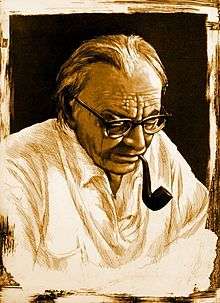Antigonae
| Antigonae | |
|---|---|
| Opera by Carl Orff | |
 | |
| Language | German |
| Based on | Friedrich Hölderlin's translation of Antigone by Sophocles |
| Premiere |
9 August 1949 Salzburg Festival |
Antigonae (Antigone), written by Carl Orff, was first presented on 9 August 1949 under the direction of Ferenc Fricsay in the Felsenreitschule, Salzburg, Austria, as part of the Salzburg Festival. Antigonae is in Orff's words a "musical setting" for the Greek tragedy of the same name by Sophocles. However, it functions as an opera.
Orff used the German translation of Sophocles' play by Friedrich Hölderlin. The original play was written in 442 BC, and the German translation copies faithfully the mood and movement of Greek tragedy.
The music
With this work Orff drew a line in his musical output, setting up a demarcation between pre-Antigonae and post-Antigonae style. Hölderlin's translation into lines of ecstatic German inspired the declamatory technique Orff uses for the first time in much of Antigonae. It pre-dates a similar style of the minimalist school by about 50 years. In this way Orff creates unusual sound effects that captures both the dramatic and psychological setting of the original Greek tragedy with emotional color ranging from the ecstatic to the orgiastic. Much of the singing is performed a cappella.
Frequently an ostinato in the orchestra builds up an almost unbearable tension which is resolved only in the final bars of the piece. Orff frequently uses the technique called Singstimmen, which is halfway between singing and speaking, somewhat like Schönberg's Sprechgesang, but still within the tonal language of work.
The sense of antiquity is often enhanced when the text is treated psalmodically in a manner resembling Gregorian Chant. Another early device found in Antigone is the melisma, where many notes are assigned to a single syllable, which is found as well in the music of other ancient and modern cultures.
The structure of the work, its heavy emotional content, its novel fabrics of sound, all demand more of the listener than required in the usual opera performance. While Antigone has never been very popular, it has set new standards for the orchestra, the singers and the committed listener.
Roles
| Role | Voice type | Premiere Cast, 9 August 1949 (Conductor: Ferenc Fricsay) |
|---|---|---|
| Antigonae | mezzo-soprano | Res Fischer |
| A messenger | bass | Josef Greindl |
| A guard | tenor | Helmut Krebs |
| Eurydice | soprano | Hilde Zadek |
| Haemon | tenor | Lorenz Fehenberger |
| Ismene | contralto | Maria von Ilosvay |
| Kreon, | baritone | Hermann Uhde |
| Tiresias | tenor | Ernst Haefliger |
Synopsis
The opera begins in the early morning following a battle in Thebes between the armies of the two sons of Oedipus: Eteocles and Polynices. King Kreon (Creon), who ascended the throne of Thebes after both brothers are killed in battle, decrees that Polynices is not to be buried. Antigonae, his sister, defies the order, but is caught. Kreon decrees that she be buried alive in spite of the fact that she is betrothed to his son, Haemon. The gods, through the blind prophet Tiresias, express their disapproval of Kreon's decision, which convinces him to rescind his order, and he goes to bury Polynices. However, Antigonae has already hanged herself rather than be buried alive. When Kreon arrives at the tomb where she was to be interred, his son, Haemon, attacks him and then kills himself. Finally, when Kreon's wife, Eurydice, is informed of Haemon's and Antigonae's death she, too, takes her own life. At the end of the play, and the opera, Kreon is the only principal left alive.
Instrumentation
According to the score, which is published by Schott Music, Antigonae is scored for an unusual orchestra with a strong percussion section. This orchestra is to be well screened from the audience when the opera is performed.
|
(*) At several points, the strings are struck with various items, including Wooden Drum sticks on the higher strings, Timpani sticks on the lower strings, and also a Plectrum.
The percussion section requires 10-15 players to perform on the following instruments:
|
|
(*) These are Orff Schulwerk instruments.
For the percussion, Carl Orff insisted on using the right kind of instruments. The two bells must be of typical shape; tubular bells and "plate" bells are not acceptable. The castanets must be of the type without handles, e.g. those only connected together via a string.
Carl Orff also gave extensive performance directions that should be taken into account at performances. For instance, some of the 12 pianists switch to other pianos at several sections. In another place, the entire trumpet section should move to just behind the stage, in action, before returning into the orchestra.